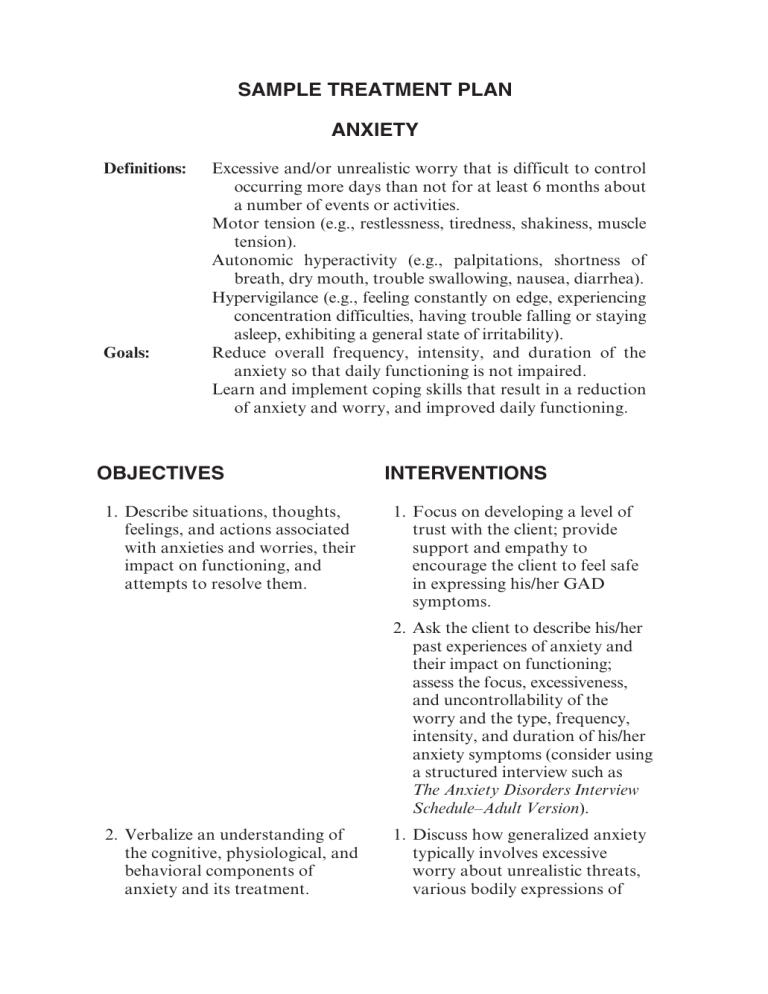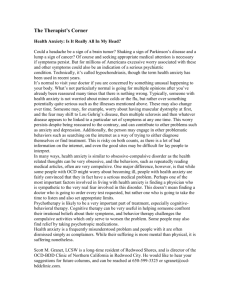
SAMPLE TREATMENT PLAN ANXIETY Definitions: Goals: Excessive and/or unrealistic worry that is difficult to control occurring more days than not for at least 6 months about a number of events or activities. Motor tension (e.g., restlessness, tiredness, shakiness, muscle tension). Autonomic hyperactivity (e.g., palpitations, shortness of breath, dry mouth, trouble swallowing, nausea, diarrhea). Hypervigilance (e.g., feeling constantly on edge, experiencing concentration difficulties, having trouble falling or staying asleep, exhibiting a general state of irritability). Reduce overall frequency, intensity, and duration of the anxiety so that daily functioning is not impaired. Learn and implement coping skills that result in a reduction of anxiety and worry, and improved daily functioning. OBJECTIVES 1. Describe situations, thoughts, feelings, and actions associated with anxieties and worries, their impact on functioning, and attempts to resolve them. INTERVENTIONS 1. Focus on developing a level of trust with the client; provide support and empathy to encourage the client to feel safe in expressing his/her GAD symptoms. 2. Ask the client to describe his/her past experiences of anxiety and their impact on functioning; assess the focus, excessiveness, and uncontrollability of the worry and the type, frequency, intensity, and duration of his/her anxiety symptoms (consider using a structured interview such as The Anxiety Disorders Interview Schedule–Adult Version). 2. Verbalize an understanding of the cognitive, physiological, and behavioral components of anxiety and its treatment. 1. Discuss how generalized anxiety typically involves excessive worry about unrealistic threats, various bodily expressions of tension, overarousal, and hypervigilance, and avoidance of what is threatening that interact to maintain the problem (see Mastery of Your Anxiety and Worry—Therapist Guide by Zinbarg, Craske, and Barlow; Treating GAD by Rygh and Sanderson). 2. Discuss how treatment targets worry, anxiety symptoms, and avoidance to help the client manage worry effectively, reduce overarousal, and eliminate unnecessary avoidance. 3. Assign the client to read psychoeducational sections of books or treatment manuals on worry and generalized anxiety (e.g., Mastery of Your Anxiety and Worry—Workbook by Craske and Barlow; Overcoming Generalized Anxiety Disorder by White). 3. Learn and implement calming skills to reduce overall anxiety and manage anxiety symptoms. 1. Teach the client calming/ relaxation skills (e.g., applied relaxation, progressive muscle relaxation, cue controlled relaxation; mindful breathing; biofeedback) and how to discriminate better between relaxation and tension; teach the client how to apply these skills to his/her daily life (e.g., New Directions in Progressive Muscle Relaxation by Bernstein, Borkovec, and Hazlett-Stevens; Treating GAD by Rygh and Sanderson). 2. Assign the client homework each session in which he/she practices relaxation exercises daily, gradually applying them progressively from non-anxietyprovoking to anxiety-provoking situations; review and reinforce success while providing corrective feedback toward improvement. 4. Learn and implement a strategy to limit the association between various environmental settings and worry, delaying the worry until a designated “worry time.” 5. Verbalize an understanding of the role that cognitive biases play in excessive irrational worry and persistent anxiety symptoms. 1. Explain the rationale for using a worry time as well as how it is to be used; agree upon a worry time with the client and implement. 2. Teach the client how to recognize, stop, and postpone worry to the agreed-upon worry time using skills such as thought stopping, relaxation, and redirecting attention (or assign “Making Use of the ThoughtStopping Technique” and/or “Worry Time” in the Adult Psychotherapy Homework Planner by Jongsma to assist skill development); encourage use in daily life; review and reinforce success while providing corrective feedback toward improvement. 1. Assist the client in analyzing his/her worries by examining potential biases such as the probability of the negative expectation occurring, the real consequences of it occurring, his/her ability to control the outcome, the worst possible outcome, and his/her ability to accept it (see “Analyze the Probability of a Feared Event” in the Adult Psychotherapy Homework Planner by Jongsma; Cognitive Therapy of Anxiety Disorders by Clark and Beck). 6. Identify, challenge, and replace biased, fearful self-talk with positive, realistic, and empowering self-talk. 1. Explore the client’s schema and self-talk that mediate his/her fear response; assist him/her in challenging the biases; replacing the distorted messages with reality-based alternatives and positive, realistic self-talk that will increase his/her selfconfidence in coping with irrational fears (see Cognitive Therapy of Anxiety Disorders by Clark and Beck). 2. Assign the client a homework exercise in which he/she identifies fearful self-talk, identifies biases in the self-talk, generates alternatives, and tests through behavioral experiments (or assign “Negative Thoughts Trigger Negative Feelings” in the Adult Psychotherapy Homework Planner by Jongsma); review and reinforce success, providing corrective feedback toward improvement. DIAGNOSIS 300.02 (F41.1)* *ICD-9-CM Code (ICD-10-CM Code) Generalized Anxiety Disorder

